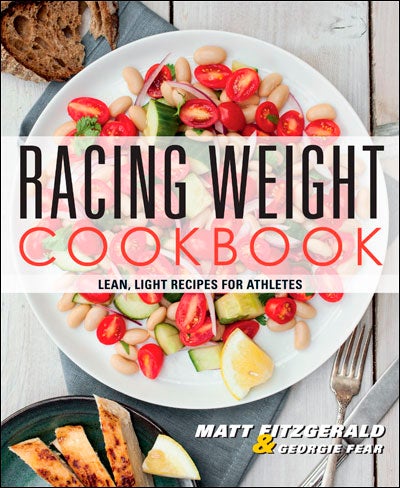Lean, Light Recipes for Athletes

Book review: Matt Fitzgerald’s Racing Weight Cookbook (+ a recipe for quinoa ‘fried rice’ and wasabi meatballs)
Matt Fitzgerald’s Racing Weight: How to Get Lean for Peak Performance, first published in 2009, offers endurance athletes guidelines for determining, then reaching, their ideal body composition for performance. In Racing Weight Cookbook: Lean, Light Recipes for Athletes, Fitzgerald, a well-known endurance sports writer and nutritionist, and Georgie Fear, a dietician and professional nutrition coach, offer 100+ healthy recipes geared toward helping endurance athletes get lean.
In the preface, Fitzgerald explains, “This is not a typical cookbook.” In fact, with many simple-does-it recipes like “Toast with Cottage Cheese & Raspberry Preserves,” this cookbook wasn’t designed for the Cordon-Bleu trained chef, but for the everyday athlete–which is exactly what will make this book so appealing to health-conscious runners who want to spend less time in the kitchen and more time on the trails.
The cookbook is divided into three phases. Within the first few pages, Fitzgerald asks you to identify with one of the following:
1. I don’t cook
2. I have some cooking experience.
3. I love to cook!
Athletes who find themselves in the first group will enjoy recipes for simple meals like “Chocolate Peanut-Butter Banana Shake” and the “White Bean, Tomato & Cucumber Salad,” shown on the front cover (and, as I can attest after making it for lunch this week, it’s both beautiful and delicious.)
For athletes who have some cooking experience, Fitzgerald and Fear offer delectable, slightly more complicated recipes such as “Vegetable Frittata” and “Seared Tuna with Mango-Cucumber Salsa.”
Finally, for those passionate about cooking and comfortable exploring more gourmet recipes, recipes such as “Apricot, Basil & Goat Cheese-Stuffed Chicken” and “Soba Noodles with Beef, Asparagus & Mushrooms” await.
The cookbook emphasizes nutritional needs for athletes, focusing especially on carbohydrates–the first few pages are dedicated to calculating your daily carbohydrate intake based on weekly training volume. For readers not already familiar with Fitzgerald’s original Racing Weight book, his six-point Racing Weight system is briefly covered in the first few pages. Each recipe also comes with a Diet Quality Score (DQS) that helps athletes looking to target their ideal racing weight tally up their calorie totals for the day.
Additionally, each recipe provides an enticing photo and the nutritional breakdown per serving, so athletes aiming for specific macronutrient goals can calculate how many grams of protein, carbs and fat they’re consuming at each meal.
Ready to try a recipe?